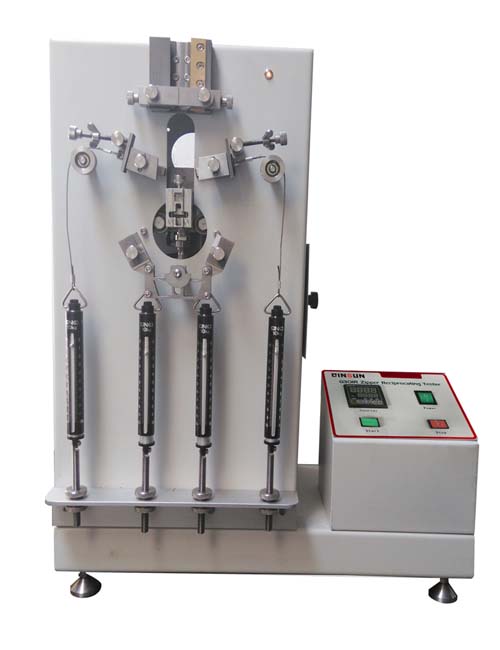
NewsInformation Center
Important Safety Information to Remember When Operating a Zipper Tester
2023/08/28
When operating a zipper tester, it's essential to prioritize safety. Here are some important safety information and guidelines to remember:
1. Read the Manual:
Familiarize yourself with the user manual provided by the manufacturer of your zipper tester. Understand the equipment's specific features, operating procedures, and safety precautions.
Familiarize yourself with the user manual provided by the manufacturer of your zipper tester. Understand the equipment's specific features, operating procedures, and safety precautions.
2. Protective Gear:
Always wear appropriate personal protective equipment (PPE) when operating the zipper tester. This may include safety glasses or goggles, gloves, and closed-toe shoes to protect against potential hazards.
Always wear appropriate personal protective equipment (PPE) when operating the zipper tester. This may include safety glasses or goggles, gloves, and closed-toe shoes to protect against potential hazards.
3. Training and Competence:
Ensure that operators are properly trained and competent in using the zipper tester. They should understand the machine's operation, testing procedures, and safety protocols. If necessary, provide additional training or seek expert guidance.
Ensure that operators are properly trained and competent in using the zipper tester. They should understand the machine's operation, testing procedures, and safety protocols. If necessary, provide additional training or seek expert guidance.
4. Machine Inspection:
Before each use, inspect the zipper tester for any signs of damage or malfunction. Check that all components, including clamps, sensors, and controls, are in good working condition. Do not operate the equipment if any issues are detected.
Before each use, inspect the zipper tester for any signs of damage or malfunction. Check that all components, including clamps, sensors, and controls, are in good working condition. Do not operate the equipment if any issues are detected.
5. Proper Setup:
Set up the zipper tester on a stable surface, following the manufacturer's instructions. Ensure that the machine is securely mounted or positioned to prevent any movement or instability during testing.
Set up the zipper tester on a stable surface, following the manufacturer's instructions. Ensure that the machine is securely mounted or positioned to prevent any movement or instability during testing.
6. Clear Workspace:
Maintain a clean and clutter-free workspace around the zipper tester. Remove any unnecessary items or obstacles that could interfere with the operation or cause potential accidents.
Maintain a clean and clutter-free workspace around the zipper tester. Remove any unnecessary items or obstacles that could interfere with the operation or cause potential accidents.
7. Electrical Safety:
If the zipper tester is electrically powered, ensure that the power source and electrical connections are safe and secure. Avoid exposing electrical components to moisture or liquids, and never tamper with or modify the electrical system.
If the zipper tester is electrically powered, ensure that the power source and electrical connections are safe and secure. Avoid exposing electrical components to moisture or liquids, and never tamper with or modify the electrical system.
8. Safe Testing Environment:
Create a controlled testing environment that minimizes risks. Keep bystanders at a safe distance from the machine during operation. Avoid distractions and focus solely on the zipper testing process.
Create a controlled testing environment that minimizes risks. Keep bystanders at a safe distance from the machine during operation. Avoid distractions and focus solely on the zipper testing process.
9. Emergency Stop:
Be aware of the emergency stop function and its location on the zipper tester. Familiarize yourself with how to quickly and safely stop the machine in case of an emergency or unexpected situation.
Be aware of the emergency stop function and its location on the zipper tester. Familiarize yourself with how to quickly and safely stop the machine in case of an emergency or unexpected situation.
10. Follow Testing Procedures:
Adhere to the recommended testing procedures provided by the manufacturer. Avoid deviating from established guidelines, as it may compromise safety or yield inaccurate results.
Adhere to the recommended testing procedures provided by the manufacturer. Avoid deviating from established guidelines, as it may compromise safety or yield inaccurate results.
11. Maintenance and Servicing:
Regularly maintain and service the zipper tester according to the manufacturer's recommendations. Follow the specified intervals for inspections, lubrication, and calibration to ensure the equipment remains in optimal condition.
Regularly maintain and service the zipper tester according to the manufacturer's recommendations. Follow the specified intervals for inspections, lubrication, and calibration to ensure the equipment remains in optimal condition.
Remember, this is a general list of safety guidelines. Always consult the specific safety instructions provided by the manufacturer of your zipper tester and adhere to any additional regulations or requirements applicable to your industry or jurisdiction.
Previous: What to pay attention to in the maintenance of fabric penetration tester?
N e x t : What is the flammability test method for fabric?




